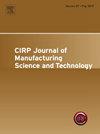Capability analysis of the dynamic R-test measuring thermo-elastic errors of a five-axis machine tool
IF 5.4
2区 工程技术
Q2 ENGINEERING, MANUFACTURING
CIRP Journal of Manufacturing Science and Technology
Pub Date : 2025-06-10
DOI:10.1016/j.cirpj.2025.05.011
引用次数: 0
Abstract
Five-axis machine tools are essential in industrial applications for their ability to efficiently machine complex geometries with high accuracy. The challenge of maintaining accuracy over long machining times is exacerbated by thermal effects that can contribute to significant geometric errors. To analyze these thermally induced geometric errors, also known as thermo-elastic errors, it is first necessary to measure them. Since the thermo-elastic state of the machine can change within a few minutes, the measurement method must have a short measurement time and the capability to measure a large number of geometric errors simultaneously. A potential promising method is the dynamic R-test, which can record the displacements of the sensor nest on the tool center point, synchronized with the actual positioning of the axes during a dynamic movement, and calculate the geometric errors using a kinematic model. The feasibility of the data acquisition method was previously demonstrated, but not the precise analysis and validation of its capability. Therefore, this study analyses the capability of the dynamic R-test to measure thermo-elastic errors in practice considering the influence of method, machine tool, human and environmental measurement uncertainties. For this purpose, numerous relevant measurement uncertainties are quantified, and a comprehensive measurement uncertainty analysis is performed using the Monte Carlo method. The results are then used to optimize the measurement method, striking a balance between time efficiency, measurement uncertainty and the number of measurable errors. They are validated by an experimental study in which thermo-elastic errors are artificially generated using the CNC geometric error compensation function on a demonstrator machine and then measured. This demonstrates the capability of the optimized dynamic R-test to measure thermo-elastic errors in practical settings, as well as a practical approach to the measurement uncertainty analysis and implementation of the dynamic R-test for five-axis machine tools.
动态r试验测量五轴机床热弹性误差的能力分析
五轴机床在工业应用中是必不可少的,因为它们能够以高精度高效地加工复杂的几何形状。在长时间的加工中保持精度的挑战会因热效应而加剧,热效应会导致显著的几何误差。为了分析这些热致几何误差,也称为热弹性误差,首先需要对它们进行测量。由于机器的热弹性状态可以在几分钟内发生变化,因此测量方法必须具有短的测量时间和同时测量大量几何误差的能力。动态r测试是一种很有前途的方法,它可以记录传感器套在刀具中心点上的位移,在动态运动过程中与轴线的实际定位同步,并利用运动学模型计算几何误差。数据采集方法的可行性先前已得到证明,但尚未对其能力进行精确分析和验证。因此,考虑方法、机床、人为和环境测量不确定性的影响,本研究分析了动态r检验在实际中测量热弹性误差的能力。为此,对众多相关的测量不确定度进行了量化,并采用蒙特卡罗方法进行了全面的测量不确定度分析。然后将结果用于优化测量方法,在时间效率、测量不确定度和可测量误差数量之间取得平衡。在实验研究中,利用CNC几何误差补偿功能在演示机上人为产生热弹性误差,然后进行测量。这证明了优化后的动态r测试在实际设置中测量热弹性误差的能力,以及对五轴机床动态r测试的测量不确定度分析和实施的实用方法。
本文章由计算机程序翻译,如有差异,请以英文原文为准。
求助全文
约1分钟内获得全文
求助全文
来源期刊

CIRP Journal of Manufacturing Science and Technology
Engineering-Industrial and Manufacturing Engineering
CiteScore
9.10
自引率
6.20%
发文量
166
审稿时长
63 days
期刊介绍:
The CIRP Journal of Manufacturing Science and Technology (CIRP-JMST) publishes fundamental papers on manufacturing processes, production equipment and automation, product design, manufacturing systems and production organisations up to the level of the production networks, including all the related technical, human and economic factors. Preference is given to contributions describing research results whose feasibility has been demonstrated either in a laboratory or in the industrial praxis. Case studies and review papers on specific issues in manufacturing science and technology are equally encouraged.
 求助内容:
求助内容: 应助结果提醒方式:
应助结果提醒方式:


